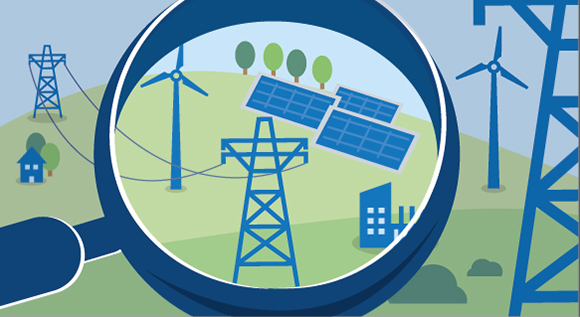What exactly is an interconnector?
In the EU, we can import cheese from France, wine from Italy and electricity from the Netherlands. But how exactly do we get this electricity across the border? Read on to find out more.
 © BMWi
© BMWiTransporting electricity across borders within the EU
As a general rule, if you travel to another country within the EU, you will be able to pass over the border without having to undergo checks. Similarly, electricity can be transported from Germany to France or from Austria to Germany without any interruptions. What the border checkpoint is for EU citizens, the interconnector is for electricity.
Linking up the grids of neighbouring countries
An interconnector is a physical link that allows electricity to be transported between two neighbouring countries. This link can take the form of an overhead powerline or an underground cable. In the EU, the electricity transmission systems of all countries are linked up via interconnectors. These make it possible to sell electricity across borders, whilst at the same time raising security of supply. For example, when there is no wind blowing in Germany, we can import hydropower from the Alpine countries. When France is experiencing a temporary shortage in electricity generation, and our wind turbines are running at full speed, we can export electricity to our French neighbours. Did you know that since 2003, Germany has been exporting more electricity than it has been importing? The latest figures stand at 56 billion kilowatt-hours and are equivalent to more than 8 per cent of our domestic consumption.
Germany – Europe’s electricity hub
The national transmission systems and the interconnectors that connect these systems between countries come together to make up the European grid. As Germany is situated at the heart of Europe, it serves as a kind of hub, with electricity flowing in from many different EU countries. Consequently, Germany also has a large number of interconnectors, particularly with Austria, Switzerland, the Netherlands and France.
And more interconnector projects are currently being developed. These include the NordLink project between Germany and Norway and the ALEGrO project between Germany and Belgium. By building these new interconnectors, Germany is also seeking to comply with European Commission rules under which every Member State needs to be able to transport 10 per cent of its electricity generation capacity to other countries by 2020. These rules are to give a further boost to European electricity trading and help build the Energy Union – an internal market for energy. Although in absolute figures, Germany has the highest number of interconnectors in the EU, it has not yet achieved the 10 per cent target. Here, smaller countries whose electricity generation capacity is lower have a clear advantage: their existing interconnectors are often sufficient to comply with the Commission’s rules.

